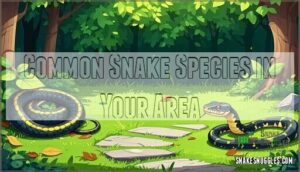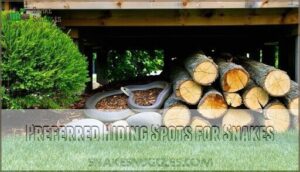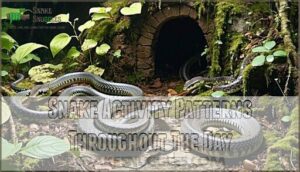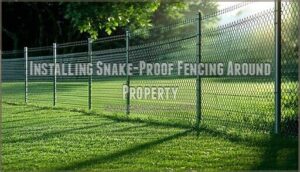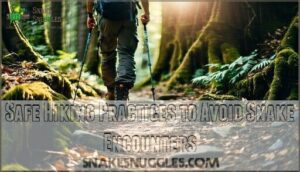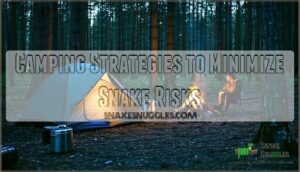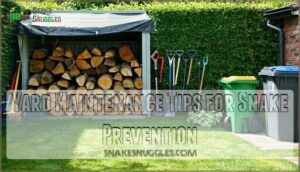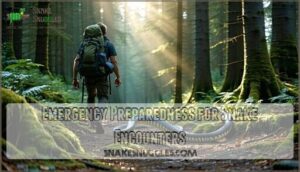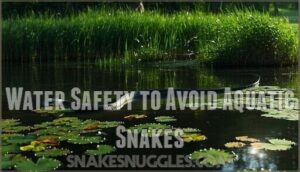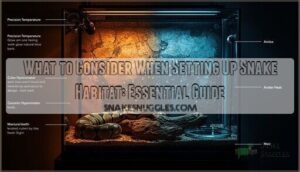This site is supported by our readers. We may earn a commission, at no cost to you, if you purchase through links.
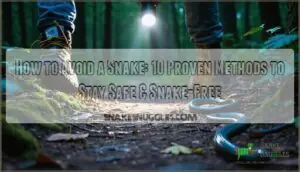
Keep your yard tidy by mowing grass short and removing brush piles where snakes hide.
When hiking, wear closed-toe shoes and use a flashlight at night.
Snakes typically avoid humans, so make noise while walking to give them time to escape.
Seal gaps around your home’s foundation and remove food sources like rodents.
If you spot a snake, don’t panic – back away slowly and give it space.
Most encounters happen when people accidentally surprise these shy creatures.
Understanding their behavior patterns reveals even more effective prevention strategies.
Table Of Contents
- Key Takeaways
- Identifying Snake Habitats and Behavior
- Creating a Snake-Proof Home Environment
- Safe Hiking Practices to Avoid Snake Encounters
- Camping Strategies to Minimize Snake Risks
- Yard Maintenance Tips for Snake Prevention
- Recognizing Signs of Snake Presence
- Effective Snake Deterrents for Your Property
- Emergency Preparedness for Snake Encounters
- Water Safety to Avoid Aquatic Snakes
- Educating Children on Snake Avoidance
- Frequently Asked Questions (FAQs)
- What will keep snakes away?
- What to do if a snake is coming at you?
- How do you avoid a snake?
- What to do if a snake chases you?
- How to avoid snake bites?
- How to avoid snakes while hiking?
- How do you keep snakes away?
- What should I do if I encounter a snake?
- What to do if a snake comes near you?
- What to do if a snake approaches you?
- Conclusion
Key Takeaways
- Maintain your yard strategically – Keep grass cut short, remove brush piles and wood stacks, seal foundation cracks, and eliminate rodent food sources to make your property unattractive to snakes.
- Wear proper protective gear outdoors – Use sturdy, closed-toe boots that reach mid-calf, long pants, and carry a flashlight when hiking or walking in areas where snakes might be present.
- Stay alert and make noise while moving – Walk on clear trails, use trekking poles to create vibrations, and avoid reaching into blind spots like rock crevices or dense vegetation where snakes commonly hide.
- Respond calmly if you encounter a snake – Don’t panic or make sudden movements; instead, back away slowly while keeping the snake in sight and give it plenty of space to escape on its own.
Identifying Snake Habitats and Behavior
You’ll find snakes in places where they can hide and hunt, like tall grass, rock piles, wood stacks, and areas near water sources.
Understanding when snakes are most active and where they prefer to shelter helps you avoid surprise encounters and stay safe in your yard and outdoor spaces, which is crucial for maintaining a safe environment.
Knowledge of snake habits is your first line of defense against unwanted backyard encounters.
Common Snake Species in Your Area
Around your neighborhood, several snake species call the same areas home that you do.
Venomous identification becomes essential when you spot copperheads in New York and New Jersey backyards.
Garter snakes frequent gardens, while water snakes patrol ponds and streams. Black rat snakes climb trees, and milk snakes hide in rocky areas. Scale patterns can aid identification.
Here are four key species to recognize:
- Garter snakes – harmless garden visitors with yellow stripes
- Copperheads – venomous with hourglass patterns
- Water snakes – non-venomous near wetlands
- Milk snakes – beneficial rodent controllers
Preferred Hiding Spots for Snakes
Knowing your local snakes helps you spot their favorite snake hiding spots. These creatures seek shelter in predictable places around your property. Snake habitat preferences include areas that offer protection and temperature control.
| Common Hiding Spots | Why Snakes Choose Them |
|---|---|
| Under Decking & Rock Piles | Cool, dark spaces with multiple escape routes |
| Wood Stacks & Compost Heaps | Attract rodents while providing cover |
| Dense Shrubs & tall grass | Perfect camouflage and protection from predators |
Regular yard maintenance and clutter removal eliminate these snake activity zones, keeping your property safer.
Snake Activity Patterns Throughout The Day
Most snakes follow predictable daily rhythms that you can use to your advantage.
Temperature directly controls when they’re active, making timing your best defense against unwanted encounters.
- Diurnal patterns: Many species hunt and move during daylight hours when temperatures are moderate
- Nocturnal hunting: Others prefer nighttime activity, especially during hot summer months
- Basking behavior: Morning sun-seekers often position themselves on rocks or open areas to warm up
Understanding these patterns helps you plan safer outdoor activities.
Seasonal Changes in Snake Behavior
Snake behavior changes dramatically with the seasons, directly affecting your snake encounters and snake prevention strategies. Understanding these patterns keeps you safer year-round.
Here’s what to expect during each season:
- Spring emergence brings hungry, active snakes from winter dormancy as temperatures hit 60°F consistently.
- Summer activity peaks during mating seasons, making snakes more aggressive and visible in their snake habitats.
- Fall preparation increases snake movement as they seek winter shelters, requiring heightened snake awareness.
Creating a Snake-Proof Home Environment
You can keep snakes away from your home by making smart changes to your yard and sealing gaps where they might enter.
These simple steps will remove the food, shelter, and access points that attract snakes to your property.
Sealing Entry Points in Your House
Now that you understand where snakes like to hide, let’s snake proof your home by blocking their entry routes.
Foundation cracks are highways for slithering visitors, so seal them with caulk or expandable foam. Check garage doorways for gaps under doors and install weather stripping.
Inspect screen repairs on windows and vents—even quarter-inch openings invite trouble. Address pipe intrusions where utilities enter your home using steel wool and caulk.
Quality sealing materials like hardware cloth work best for larger openings. Proper foundation repair and snake barriers create effective snake prevention that keeps your home secure.
Proper Landscaping to Deter Snakes
After securing your home’s entry points, transform your yard into a snake-deterrent landscape.
Mulch alternatives like crushed stone or river rock replace wood chips that attract snakes. Keep your lawn maintenance consistent with regular mowing—short grass improves visibility and reduces hiding spots.
Strategic plant placement matters: relocate dense shrubs and thick plants at least 24 inches from your foundation. Trim vegetation to maintain ground clearance.
Water management prevents overwatering that attracts prey like slugs and worms. Store firewood and debris away from your home.
These snake proofing techniques create an unwelcoming environment for unwanted visitors. Some homeowners purchase snake repellent products for added security.
Removing Potential Food Sources for Snakes
Your beautiful landscaping won’t help if you’re accidentally feeding snakes.
Rodent control starts with sealing entry points and storing pet food in metal containers. Clean up birdseed storage spills that attract mice.
Eliminate standing water sources like leaky hoses or clogged gutters.
Insect management means removing debris piles where bugs hide.
These snake food sources disappear when you control the pest management chain – no prey means no predators hanging around your property.
Installing Snake-Proof Fencing Around Property
After eliminating food sources, you’ll want proper fencing materials to complete your snake-proof barrier. Snake fencing types vary, but galvanized steel mesh with 1/4-inch openings works best for most properties.
Installation depth matters—bury your fence 6 inches underground and extend it 30 inches above ground. Angled barriers tilted outward at 30 degrees stop climbing attempts effectively.
Choose snake fencing materials that resist rust and weather damage. You can find various fencing products to suit your needs.
Snake fencing installation requires careful attention to mesh size consistency throughout your perimeter. Don’t forget gate sealing around entry points where gaps commonly form.
- Select galvanized steel over plastic for durability
- Maintain consistent 1/4-inch mesh size across all sections
- Angle fence tops outward to prevent snake climbing
- Inspect regularly for gaps or damage that compromise snake fencing effectiveness
Safe Hiking Practices to Avoid Snake Encounters
When you’re hiking in areas where snakes live, the right preparation and awareness can keep you safe from unexpected encounters.
You’ll learn essential techniques like choosing proper gear, staying alert on trails, and traversing rocky terrain where snakes often hide, which will help you stay safe with awareness.
Choosing Appropriate Footwear and Clothing
Building on your snake-proof home foundation, your hiking gear becomes your portable defense system. Boot Materials matter most—choose thick leather that reaches mid-calf height. Canvas or denim pants with proper Pant Length covering your boots create essential barriers. Sock Thickness adds another protective layer beneath sturdy footwear.
Gaiter Benefits can’t be overstated for serious snake avoidance. These leg shields wrap around boots and calves, blocking fangs from penetrating fabric gaps. Smart Layering Strategies combine multiple protection levels for maximum hiking safety.
| Protection Level | Gear Type |
|---|---|
| Primary | Snake boots with thick leather |
| Secondary | Heavy-duty snake pants |
| Additional | Snake gaiters or chaps |
| Base Layer | Thick hiking socks |
| Complete System | All layers combined |
Using Trekking Poles to Navigate Terrain
When traversing snake-prone terrain, trekking poles become your primary defense system.
These versatile tools offer balance assistance on uneven ground while providing uphill leverage during steep climbs.
Use terrain probing techniques to test areas before stepping, and create pole vibrations that alert hidden snakes to your presence.
The clearing vegetation function helps part dense brush safely, enhancing your hiking safety and outdoor safety practices.
Knowing how to spot defensive snake behavior can also substantially improve your safety.
Staying Alert and Observant on Trails
Trail awareness becomes your best defense when hiking through snake country.
Scan surroundings constantly, checking the path ahead and beside you for camouflaged snakes blending into leaf litter.
Avoid distractions like phones or loud music that prevent you from hearing rustling sounds.
Watch footing carefully, especially near rocks and logs where snakes hide.
Listen carefully for warning rattles or movement in brush.
Stay focused on snake safety by maintaining visual contact with the trail ahead.
Proper Techniques for Crossing Rocky Areas
Rocky terrain presents unique challenges for snake avoidance techniques, as these areas provide perfect hiding spots for various species.
Snakes blend seamlessly with rocks, making visual scanning critical for snake safety.
Follow these essential steps when crossing rocky areas:
- Test each rock’s stability before placing your full weight
- Use pole usage to probe crevices and gaps ahead of your path
- Maintain proper step height by stepping onto rocks rather than over them
- Focus on foot placement on stable, flat surfaces away from shadowy gaps
- Practice balance control while scanning for movement or unusual shapes
This approach prevents snake bite prevention emergencies in snake infested areas.
Camping Strategies to Minimize Snake Risks
When you’re camping in snake territory, choosing the right campsite and setting up properly can make the difference between a peaceful night and an unwelcome visitor in your tent.
You’ll need to focus on four key areas: picking a safe location, securing your tent, storing food correctly, and staying alert after dark.
Selecting an Ideal Campsite Location
Location scouting separates smart campers from snake encounter stories.
Terrain Assessment reveals hidden dangers.
Choose open clearings over dense brush where snake sightings commonly occur.
Sunlight Exposure helps you spot movement, while Water Access should be distant—snakes love moisture.
Shelter Availability from natural windbreaks beats rocky outcrops.
Always plan Escape Routes before unpacking.
| Ideal Campsite Features | Avoid These Areas |
|---|---|
| Open clearings with visibility | Dense brush and tall grass |
| Higher ground with good drainage | Low-lying wet areas |
| Distance from water sources | Stream banks and pond edges |
| Minimal rock piles or logs | Rocky outcrops and woodpiles |
| Clear escape paths | Dead-end locations |
Snake safety tips start with smart site selection.
Proper Tent Setup and Maintenance
Your campsite’s locked down, but your tent needs the same attention. Tent sealing starts with a quality groundsheet beneath your shelter—it blocks moisture and creates a barrier snakes can’t penetrate. Check every zipper before you sleep; zipper maintenance means testing pulls and inspecting tracks for debris. Snakeproof tents require ventilation strategies that keep air flowing while maintaining security.
Here’s your tent fortress checklist:
- Seal every gap with duct tape, leaving no entry points
- Position tent stakes firmly to prevent fabric sagging
- Keep tent walls taut to eliminate hiding spaces underneath
Proper setup transforms ordinary camping gear into snake avoidance armor.
Safe Food Storage Practices
Your tent’s secure, but hungry snakes still hunt for easy meals around campsites. Smart airtight containers and metal bins prevent food odors from attracting snake prey like rodents and insects.
Smart food storage isn’t just about bears—it’s your first line of defense against slithering campsite visitors.
Never store snacks in your tent—it’s like ringing a dinner bell for unwanted visitors.
Here’s your campsite storage strategy:
Smell-proof bags
Prompt cleanup after meals matters too. Wash dishes immediately and pack away leftovers in secure storage. This snake avoidance approach creates truly snakeproof camping areas.
Night-time Safety Precautions
After securing your food properly, nighttime brings unique snake dangers that require specific precautions.
Most snakes are active during cooler evening hours, making darkness your biggest challenge for snake safety.
Your campsite transforms into potential snake territory once the sun sets.
Smart campers know that avoiding snakes requires preparation and vigilance during these vulnerable hours.
- Night lighting around your perimeter deters snake activity and improves snake identification
- Flashlight essentials include headlamps and backup batteries for safe movement
- Reflective gear on tent guy-lines prevents accidental snake encounters
- Audible alerts like talking or footsteps warn snakes of your presence
- Buddy system guarantees someone’s watching for snake bites during nighttime activities
Yard Maintenance Tips for Snake Prevention
Your yard can either welcome snakes or keep them away, and the difference lies in how you maintain it.
Simple changes like cutting grass short, clearing brush, and storing materials properly create an environment that snakes won’t find appealing, which can be achieved by making simple changes to your yard maintenance routine, focusing on properly storing materials.
Regular Grass Mowing and Brush Clearing
Keep your grass short through regular mowing frequency to eliminate snake hiding spots.
Weekly grass mowing during growing seasons prevents tall vegetation that attracts snakes.
Use proper brush removal techniques with well-maintained tools for safe clearing around your property.
Trim shrubs maintaining 24-inch ground clearance for maximum habitat impact.
Avoid overwatering your lawn, as excess moisture attracts prey like worms and frogs.
This outdoor maintenance approach combined with strategic landscaping and debris removal creates an unwelcoming environment for snakes.
Proper Storage of Firewood and Building Materials
Beyond maintaining short grass, your firewood storage and debris removal practices directly impact home protection.
Snakes love hiding in messy woodpiles and scattered building materials.
Smart Storage Location and Stacking Techniques prevent snake intrusion:
- Store firewood at least 20 feet from your house on concrete or gravel platforms
- Stack materials in neat, elevated piles to eliminate Ground Contact and hiding spots
- Practice Moisture Control by covering stored items with tarps for effective Pest Prevention
This outdoor maintenance creates truly snakeproof yards.
Managing Compost and Debris Piles
Improper compost management creates perfect snake hideouts, but smart debris relocation transforms danger zones into safe spaces.
Turn your compost weekly and maintain proper pile composition with balanced green-brown materials for effective snake control.
| Management Task | Snake Prevention Benefit | Maintenance Frequency |
|---|---|---|
| Turn compost pile | Eliminates hiding spots | Weekly |
| Remove debris piles | Reduces shelter options | Monthly |
| Safe burning of brush | Clears snake habitat | Seasonally |
| Rodent control measures | Removes food sources | Ongoing |
This pest control approach works better than expensive snake repellent products while enriching your soil naturally.
Creating Natural Barriers With Plants
Beyond tidying debris, you can use plant selection to discourage unwanted visitors.
Dense vegetation attracts snakes, but strategic placement of certain plants creates effective barriers. Smart gardening turns your yard into a natural fortress against garden snakes.
Choose these repellent plants for maximum protection:
- Marigolds: Their pungent scent works as natural snake deterrents
- Lemongrass: Creates aromatic barriers snakes avoid
- Thorny bushes: Physical obstacles that discourage movement
- Garlic plants: Release sulfur compounds that repel snakes
Plant these shrubs strategically around your property’s perimeter for best results. It’s also important to keep in mind non-toxic plant alternatives if snakes are present.
Recognizing Signs of Snake Presence
Snakes leave behind clear clues that can help you spot their presence before you encounter them directly.
You’ll learn to recognize tracks, shed skins, droppings, and unusual changes in your local wildlife that signal snakes are nearby, which can include recognizing droppings.
Identifying Snake Tracks and Markings
Spotting snake tracks transforms you into a wildlife detective in potential snake territory. These sinuous trails appear as smooth, curved impressions where scales contacted the ground.
Track substrates like soft dirt or sand reveal the clearest evidence of recent snake movement.
| Track Feature | What to Look For |
|---|---|
| Scale patterns | Parallel ridges from belly scales |
| Width variations | Thicker sections show body diameter |
| Directional clues | Substrate pushed opposite travel direction |
| Fresh vs. old | Sharp edges indicate recent passage |
| Species hints | Track width suggests snake size |
Detecting Snake Odors and Sounds
Can you trust your nose and ears to detect hidden snakes? Your senses often pick up snake presence before your eyes do.
Snake musk creates a distinct cucumber-like or musky odor that lingers in their territory.
Listen for these critical rattlesnake sounds and snake vibrations:
- Soft rustling through dry leaves or grass
- Low hissing when snakes feel threatened
- Sharp rattling from defensive rattlesnake tails
These snake defense mechanisms give you precious warning time.
Spotting Snake Skins and Droppings
Snake skins and droppings reveal vital details about nearby snake territory. Look for translucent, papery shed skins near rocks, logs, or dense vegetation – prime snake habitat areas.
Skin identification helps determine species size and type. Dropping analysis shows recent activity; snake waste appears tubular with white caps, unlike bird droppings.
Shedding frequency varies by species and season. Check dropping locations around water sources and shelter spots.
Fresh skin condition indicates active snake camouflage zones requiring extra caution during snake avoidance efforts. Such findings can be alarming, but remember that discarded snake skins are common.
Noticing Changes in Local Wildlife Behavior
When prey population shifts occur in your area, it’s often a red flag for snake presence.
Watch for unusual migration patterns among small mammals and altered feeding habits in local birds. You might notice increased aggression in territorial animals or decreased visibility of typical backyard critters.
These behavioral changes signal that predators have moved in. Contact wildlife management, animal control, or pest control if these patterns persist, as understanding snake behavior helps with effective snake avoidance.
Effective Snake Deterrents for Your Property
You can protect your property from snakes by using proven deterrent methods that make your yard less attractive to these reptiles.
These strategies include natural repellents, ultrasonic devices, and encouraging predators that naturally control snake populations around your home, using methods that are proven.
Natural Repellents and Their Effectiveness
Natural deterrents offer mixed results when you’re seeking snake-free spaces. Essential oils like peppermint and citrus show limited effectiveness, while sulfur effectiveness remains scientifically unproven. Predator urine and commercial plant repellents lack consistent research backing. DIY repellents using coffee grounds or garlic require frequent reapplication.
Many homeowners are now using snake repellent plants for a natural solution.
- Your peace of mind shouldn’t rely on unproven methods
- Children and pets deserve protection that actually works
- Time spent on ineffective snake smells could be better invested
Focus on proven snake avoidance strategies instead.
Ultrasonic Devices for Snake Prevention
Don’t fall for the marketing hype around ultrasonic devices for snake prevention. Despite flashy advertisements and impressive user reviews, these gadgets simply don’t deliver on their promises. Snakes can’t detect ultrasonic sounds, making these devices about as effective as a chocolate teapot for pest control.
The hard truth is that ultrasonic snake repellents lack scientific backing. Australian snake hunter Mark Pelley proved that vibrations and sounds don’t deter snakes. Even solar-powered models claiming to emit ground vibrations fall short of expectations.
Here’s what actually works for snake prevention:
- Physical barriers: Install proper snake fencing with mesh smaller than ¼ inch
- Habitat modification: Remove hiding spots like brush piles and dense vegetation
- Professional snake removal: Address existing infestations before trying deterrents
- Environmental impact: Choose methods that don’t harm beneficial wildlife
Skip the ultrasonic gimmicks and invest in proven snake repellents that actually protect your property.
Biological Control Methods Using Predators
Through predator introduction, you can harness nature’s own pest control system.
Encouraging natural enemies like hawks, owls, and king snakes creates effective animal control without chemicals. Habitat manipulation works best—install bird houses to attract raptors that hunt snakes.
Consider these proven snake predators:
This pest management approach targets the snake diet cycle, making your property less attractive to unwanted visitors while supporting natural snake relocation.
Emergency Preparedness for Snake Encounters
Even with the best prevention methods, you might still encounter a snake unexpectedly, so preparing for these situations can make the difference between a safe outcome and a dangerous one.
You’ll need specific supplies, knowledge of first aid techniques, and proper tools to handle snake bite emergencies effectively until professional medical help arrives, which requires proper preparation.
Essential Items for a Snake Safety Kit
Having deterrents isn’t enough—you need a proper snake first aid kit ready for emergencies.
Your kit should include bandages, antiseptic wipes, and a permanent marker for bite identification timing.
Pack a compression bandage (never a tourniquet), pain relievers, and emergency contact cards with your evacuation plan and nearest antivenom access locations.
- Elastic bandages for wound cleaning and compression wrapping
- Waterproof marker to mark bite progression timing
- Emergency contact list including poison control numbers
- GPS device or whistle for signaling rescue teams
First Aid Techniques for Snake Bites
When a snake bite occurs, your response can mean the difference between life and death. Call emergency services immediately – don’t wait to see if symptoms develop.
Remove jewelry and tight clothing before swelling starts, then clean the bite gently with soap and water. Keep the wound below heart level and stay as still as possible to slow venom spread through your system.
Don’t fall for dangerous myths like applying ice, cutting the wound, or using tourniquets. These snake bite treatment mistakes can cause more harm than the bite itself.
Focus on Wound Care basics and Immobilization Techniques while awaiting professional Antivenom Administration.
When a snake bite occurs, your response can mean the difference between life and death. Call emergency services immediately – don’t wait to see if symptoms develop.
Remove jewelry and tight clothing before swelling starts, then clean the bite gently with soap and water. Keep the wound below heart level and stay as still as possible to slow venom spread through your system.
Don’t fall for dangerous myths like applying ice, cutting the wound, or using tourniquets. These snake bite treatment mistakes can cause more harm than the bite itself.
Focus on Wound Care basics and Immobilization Techniques while awaiting professional Antivenom Administration.
Proper Use of Snake Bite Extraction Tools
Most snake bite extraction tools don’t work as advertised.
Research shows suction devices remove only 2% of snake venom, making extractor effectiveness nearly useless.
Don’t waste precious time with these gadgets – focus on getting medical help immediately.
If you’re carrying snake first aid kits with extractors, skip the suction duration recommendations.
Making incisions creates infection risks without removing venom.
Your energy’s better spent staying calm and keeping the bite below heart level.
Prevention beats any tool: watch your step and maintain distance from snakes.
Water Safety to Avoid Aquatic Snakes
You’ll encounter aquatic snakes in lakes, rivers, ponds, and marshes where they hunt for fish and amphibians.
These water-dwelling species can swim silently beneath the surface and may approach boats or swimmers, so you need specific safety strategies to avoid dangerous encounters near water.
Identifying Water Snake Species
Water snake ID starts with recognizing key differences between harmless species and their venomous look-alikes.
Nonvenomous snakes like common watersnakes have slender heads that blend smoothly into their necks, while dangerous cottonmouths display blocky heads with narrow necks.
Notice behavior patterns too – water snakes swim with bodies submerged, but cottonmouths float on the surface.
Habitat variations include rivers, lakes, and ponds where snake identification becomes critical for safety.
Safe Swimming Practices in Snake-Prone Areas
Swimming in snake-infested waters requires careful preparation and awareness.
Before entering any swimming area, conduct a thorough Swimming Area Inspection of the shoreline and shallow water for signs of water snakes.
Follow proper Water Entry Protocol by entering slowly and making noise to alert snakes of your presence.
Stick to designated swimming zones with clear visibility, avoiding areas with dense vegetation or murky water.
Always perform Post-Swim Checks of your belongings and surroundings, as Poolside Snake Prevention includes securing your gear properly.
Boat Safety Measures Against Snake Intrusion
Boaters face unique challenges when traveling through snake-infested waters, but proper preparation keeps you safe.
Protect your vessel with these essential measures:
- Seal Entryways – Install fine mesh screens over vents, drains, and storage compartments to prevent snake access
- Docking Precautions – Check dock lines and fenders before boarding, as snakes often hide in these areas
- Onboard Deterrents – Place mothballs in mesh bags around your slip to repel snakes and their prey
- Emergency Kit – Keep snake identification guides and first aid supplies readily accessible onboard
Recognizing Snake Behavior in Water
V-shaped ripples cutting through calm water signal a swimming snake nearby.
Watch for their distinctive S-curve motion and head held above surface. Most water snakes dive for 5-10 minutes when hunting, then resurface to breathe.
They’ll quickly escape toward shore or underwater cover when they spot you. Understanding these water escape behaviors helps you maintain safe distance in snake-infested waters during your snake-safe swimming adventures.
Educating Children on Snake Avoidance
Teaching your children about snake safety creates lifelong habits that protect them during outdoor adventures.
You’ll give them the skills to identify dangerous snakes, recognize safe play areas, and respond correctly when they spot these reptiles in their path.
Teaching Snake Identification Skills
Beyond water safety, giving your children proper snake education builds lifelong awareness.
Teaching snake identification starts with understanding the basics of venomous vs. non-venomous species through regional snake ID guides specific to your area.
Focus on these key identification methods:
- Head shape and eye pupils – Venomous snakes typically have triangular heads and vertical pupils, while non-venomous species have rounded heads and round pupils
- Pattern recognition and size indicators – Learn distinctive markings like diamond patterns on rattlesnakes or banded colors on coral snakes
- Behavior cues and movement – Observe how different species coil, strike positioning, and tail movements like rattling
Use snake identification apps and field guides to practice together.
Make snake facts engaging by comparing local species to pictures.
Remember, snake information isn’t about creating fear – it’s about building snake awareness that keeps your family safe while respecting wildlife.
Role-Playing Snake Encounter Scenarios
Family practice sessions turn snake education into engaging learning experiences.
Create reaction drills using rubber snakes to teach proper responses: freeze, back away slowly, alert adults.
Focus on fear management through repeated child roleplay scenarios.
Practice "What if?" situations like finding snakes near playgrounds or walking trails.
These safety precautions build confidence for real snake encounters while reinforcing habitat awareness and snake bite avoidance techniques.
Establishing Safe Play Areas Outdoors
How can you transform your backyard into a snake-free haven for your children? Start by installing playground fencing with mesh smaller than 1/4 inch around play areas.
Create safe surfaces using gravel or concrete rather than mulch where snakes hide. Establish supervised play zones with clear sightlines and toy storage in sealed containers.
Keep first aid supplies nearby and maintain snakeproof gardens by removing debris piles.
- Your child’s laughter shouldn’t be interrupted by fear
- Peace of mind comes from proper snake avoidance preparation
- Snakeproof homes start with protected outdoor spaces
Instilling Respect for Wildlife in Children
Building wildlife appreciation starts with teaching your children that snakes deserve our Respectful Observation from a safe distance.
Focus on Coexistence Education by explaining how snakes control rodent populations and maintain ecosystem balance.
Encourage Responsible Interaction through nature documentaries and guided discussions about Habitat Preservation.
Help kids distinguish between Fear vs. Respect – snakes aren’t monsters, they’re important wildlife that need space.
Practice snake awareness through role-playing scenarios, emphasizing never touching or approaching any snake.
This environmental awareness builds confident, nature-loving children who understand snake precautions during wildlife encounters.
Frequently Asked Questions (FAQs)
What will keep snakes away?
Like a fortress protecting its treasures, you’ll keep snakes away by removing their hiding spots—clear brush, trim grass short.
Seal foundation cracks, eliminate rodent food sources, and store firewood away from your home.
What to do if a snake is coming at you?
Stay calm and slowly back away while keeping the snake in sight.
Don’t make sudden movements or turn your back.
Most snakes won’t chase you—they’re more scared of you than you’re of them, so it’s essential to remember that most snakes won’t be aggressive.
How do you avoid a snake?
Keep your yard clean by removing clutter, wood piles, and tall grass where snakes hide.
Walk carefully on trails, wear boots, use a flashlight at night, and make noise to alert snakes of your presence, especially to alert snakes.
What to do if a snake chases you?
Snakes rarely chase humans – only 2% of encounters involve pursuit.
If one follows you, don’t run in zigzags.
Walk away steadily while facing the snake, as they’ll likely stop once you’re no longer a perceived threat.
How to avoid snake bites?
Wear sturdy boots and long pants when outdoors.
Watch where you step, especially near rocks and logs.
Use a flashlight at night. Don’t reach into blind spots.
Stay on clear trails whenever possible.
How to avoid snakes while hiking?
Most people think snakes are lurking everywhere, but they’re actually trying to avoid you too.
Use trekking poles to create vibrations, stick to clear trails, wear sturdy boots, and step on logs rather than over them.
How do you keep snakes away?
Remove hiding spots like woodpiles and tall grass from your yard.
Seal cracks in foundations and doorways.
Keep your lawn mowed short, eliminate food sources, and use gravel instead of mulch around your home to remove potential habitats.
What should I do if I encounter a snake?
Stay calm and back away slowly.
Don’t make sudden movements or try to kill it. Give the snake plenty of space to escape.
Most snakes aren’t aggressive and will flee if you don’t threaten them, so it’s essential to stay calm and let them escape without feeling threatened.
What to do if a snake comes near you?
Back away slowly and give the snake plenty of space to escape.
Don’t make sudden movements or try to kill it.
Most snakes will flee if you remain calm and still.
What to do if a snake approaches you?
Imagine this scenario: a snake’s slithering toward you, and your heart races.
Don’t panic! Move slowly backward, keeping your eyes on it.
Give the snake space to escape—it’s likely more afraid than you are.
Conclusion
Surprisingly, snakes aren’t plotting elaborate schemes to terrorize humans – they’re simply trying to avoid us too.
By implementing these proven methods on how to avoid a snake, you’ll create safer outdoor experiences for yourself and your family.
Remember that consistent yard maintenance, proper hiking gear, and staying alert are your best defenses.
Most snake encounters result from accidental surprises, so making noise and giving these creatures space protects everyone involved.
- https://www.universalcitytexas.gov/704/How-To-Deal-With-Snakes-Around-Your-Home
- https://www.quora.com/How-do-I-prevent-snakes-to-come-around-the-home-or-enter
- https://www.greenwoodnursery.com/blog/13-ways-help-keep-snakes-away-your-house?srsltid=AfmBOor--Gr4uAoeZ2gua9OQdMU4SQVlNLFN68ptlXlaqgpXeA9BT8tb
- https://keithandlindsey.com/how-to-avoid-snakes-while-hiking/
- https://www.army.mil/article/235084/the_dos_and_donts_of_snake_safety

